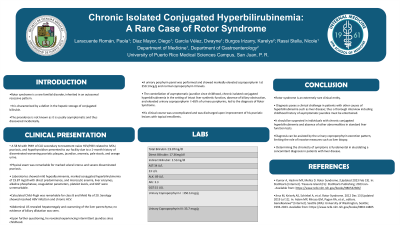Sunday Poster Session
Category: Liver
P1053 - Chronic Isolated Conjugated Hyperbilirubinemia: A Rare Case of Rotor Syndrome
Sunday, October 22, 2023
3:30 PM - 7:00 PM PT
Location: Exhibit Hall

Has Audio

Paola Laracuente Roman, MD
University of Puerto Rico, Medical Sciences Campus
San Juan, Puerto Rico
Presenting Author(s)
Paola Laracuente-Román, MD1, Diego J. Diaz-Mayor, MD2, Dwayne García-Vélez, MD3, Karelys Burgos-Irizarry, MD4, Nicole Rassi-Stella, MD3
1University of Puerto Rico, Medical Sciences Campus, San Juan, Puerto Rico; 2VA Caribbean Healthcare System, San Juan, Puerto Rico; 3University of Puerto Rico, San Juan, Puerto Rico; 4University of Puerto Rico Medical Sciences Campus, San Juan, Puerto Rico
Introduction:
Rotor syndrome is a rare familial disorder, inherited in an autosomal recessive pattern. It is characterized by a defect in the hepatic storage of conjugated bilirubin. The prevalence is not known as it is usually asymptomatic and thus discovered incidentally.
Case Description/Methods: A 58 M with PMH of CLD secondary to treatment naïve HCV/HBV related to IVDU, psoriasis, and hypothyroidism presented to our facility due to a 1-month history of disseminated worsening psoriatic plaques, jaundice, anorexia, pale stools, and orange urine. Physical exam was remarkable for marked scleral icterus and severe disseminated psoriasis. Laboratories showed mild hypoalbuminemia, marked conjugated hyperbilirubinemia of 19.87 mg/dl with direct predominance, and microcytic anemia, liver enzymes, alkaline phosphatase, coagulation parameters, platelet levels, and GGT were unremarkable. Calculated Child-Pugh was remarkable for class B and Meld Na of 20. Serology showed resolved HBV infection and chronic HCV. Abdominal US revealed hepatomegaly and coarsening of the liver parenchyma; no evidence of biliary dilatation was seen. Upon further questioning, he revealed experiencing intermittent jaundice since childhood. A urinary porphyrin panel was performed and showed markedly elevated coproporphyrin I at 350.1mcg/g and normal coproporphyrin III levels. The constellation of asymptomatic jaundice since childhood, chronic isolated conjugated hyperbilirubinemia in the setting of intact liver synthetic function, absence of biliary obstruction, and elevated urinary coproporphyrin I >65% of urinary porphyrins, led to the diagnosis of Rotor Syndrome. His clinical course was uncomplicated and was discharged upon improvement of his psoriatic lesions with topical emollients.
Discussion:
Rotor syndrome is an extremely rare clinical entity. Diagnosis poses a clinical challenge in patients with other causes of hyperbilirubinemia such as liver disease; thus a thorough interview including childhood history of asymptomatic jaundice must be entertained. It should be suspected in individuals with chronic conjugated hyperbilirubinemia and absence of other abnormalities in standard liver function tests. Diagnosis can be assisted by the urinary coproporphyrin excretion pattern, limiting the role of invasive measures such as liver biopsy. Determining the chronicity of symptoms is fundamental in elucidating a concomitant diagnosis in patients with liver disease.
Disclosures:
Paola Laracuente-Román, MD1, Diego J. Diaz-Mayor, MD2, Dwayne García-Vélez, MD3, Karelys Burgos-Irizarry, MD4, Nicole Rassi-Stella, MD3. P1053 - Chronic Isolated Conjugated Hyperbilirubinemia: A Rare Case of Rotor Syndrome, ACG 2023 Annual Scientific Meeting Abstracts. Vancouver, BC, Canada: American College of Gastroenterology.
1University of Puerto Rico, Medical Sciences Campus, San Juan, Puerto Rico; 2VA Caribbean Healthcare System, San Juan, Puerto Rico; 3University of Puerto Rico, San Juan, Puerto Rico; 4University of Puerto Rico Medical Sciences Campus, San Juan, Puerto Rico
Introduction:
Rotor syndrome is a rare familial disorder, inherited in an autosomal recessive pattern. It is characterized by a defect in the hepatic storage of conjugated bilirubin. The prevalence is not known as it is usually asymptomatic and thus discovered incidentally.
Case Description/Methods: A 58 M with PMH of CLD secondary to treatment naïve HCV/HBV related to IVDU, psoriasis, and hypothyroidism presented to our facility due to a 1-month history of disseminated worsening psoriatic plaques, jaundice, anorexia, pale stools, and orange urine. Physical exam was remarkable for marked scleral icterus and severe disseminated psoriasis. Laboratories showed mild hypoalbuminemia, marked conjugated hyperbilirubinemia of 19.87 mg/dl with direct predominance, and microcytic anemia, liver enzymes, alkaline phosphatase, coagulation parameters, platelet levels, and GGT were unremarkable. Calculated Child-Pugh was remarkable for class B and Meld Na of 20. Serology showed resolved HBV infection and chronic HCV. Abdominal US revealed hepatomegaly and coarsening of the liver parenchyma; no evidence of biliary dilatation was seen. Upon further questioning, he revealed experiencing intermittent jaundice since childhood. A urinary porphyrin panel was performed and showed markedly elevated coproporphyrin I at 350.1mcg/g and normal coproporphyrin III levels. The constellation of asymptomatic jaundice since childhood, chronic isolated conjugated hyperbilirubinemia in the setting of intact liver synthetic function, absence of biliary obstruction, and elevated urinary coproporphyrin I >65% of urinary porphyrins, led to the diagnosis of Rotor Syndrome. His clinical course was uncomplicated and was discharged upon improvement of his psoriatic lesions with topical emollients.
Discussion:
Rotor syndrome is an extremely rare clinical entity. Diagnosis poses a clinical challenge in patients with other causes of hyperbilirubinemia such as liver disease; thus a thorough interview including childhood history of asymptomatic jaundice must be entertained. It should be suspected in individuals with chronic conjugated hyperbilirubinemia and absence of other abnormalities in standard liver function tests. Diagnosis can be assisted by the urinary coproporphyrin excretion pattern, limiting the role of invasive measures such as liver biopsy. Determining the chronicity of symptoms is fundamental in elucidating a concomitant diagnosis in patients with liver disease.
Disclosures:
Paola Laracuente-Román indicated no relevant financial relationships.
Diego Diaz-Mayor indicated no relevant financial relationships.
Dwayne García-Vélez indicated no relevant financial relationships.
Karelys Burgos-Irizarry indicated no relevant financial relationships.
Nicole Rassi-Stella indicated no relevant financial relationships.
Paola Laracuente-Román, MD1, Diego J. Diaz-Mayor, MD2, Dwayne García-Vélez, MD3, Karelys Burgos-Irizarry, MD4, Nicole Rassi-Stella, MD3. P1053 - Chronic Isolated Conjugated Hyperbilirubinemia: A Rare Case of Rotor Syndrome, ACG 2023 Annual Scientific Meeting Abstracts. Vancouver, BC, Canada: American College of Gastroenterology.
